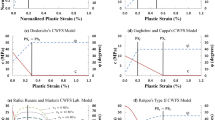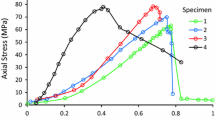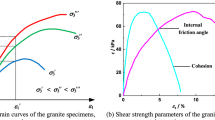Abstract
Rock strength is generally divided into the components of cohesion and internal friction. These components are two important parameters for estimating the damaged or disturbed zone around an excavation and its corresponding support design. However, the cohesive and frictional strength components at the same strain increment before peak strength are difficult to separate from each other. In addition, the misperception of their mutual evolution has been in existence for a long time. A numerical code, Rock Failure Process Analysis (RFPA2D), based on the finite element method was used in this study to clarify this misperception. The RFPA2D approach can account for rock heterogeneity and capture the entire rock failure process without prior assumptions regarding where and how microcracks and fracturing develop. Numerical models of rock were copied and reused in uniaxial and biaxial tests to create identical heterogeneous models for use under different confining stress conditions. Forty-five numerical tests (5 homogeneity indexes × 9 confining pressures) were used to calculate the results of the principal stresses (σ 1 and σ 3) at specified increments of axial strain. The intercept and the slope of a linear line fitting to the principal stresses at the same strain before peak strength were obtained in the principal stress space. The intercept is related to the cohesive strength component of the shear resistance, and the slope of the linear line is a pseudo-internal friction coefficient. Through the analysis of the linear fitting results, it has been found that the cohesive strength component increases while the pseudo-internal friction coefficient decreases with increasing homogeneity index of the numerical rock models. The values of cohesion and internal friction vary as a function of the strain state, and they are immediately activated with a strain increment before peak strength. The research results strengthen the understanding of the mobilization of the load-bearing capacity of rock mass surrounding an opening and can improve the design of practical support systems.



















Similar content being viewed by others
References
Byerlee JD (1978) Friction of rocks. Pure Appl Geophys 116:615–626
Cai M, Kaiser PK (2005) Assessment of excavation damaged zone using a micromechanics model. Tun Under Space Tech 20(4):301–310
Faulkner DR, Mitchell TM, Healy D, Heap MJ (2006) Slip on ‘weak’ faults by the rotation of regional stress in the fracture damage zone. Nature 444:922–925
Feng ZJ, Zhou DP, Zhou YH, Wang YM (2005) Triaxial experiment study of stress–strain curves of soft rock in red layer. Roadbed Eng (in Chinese) 6:32–35
Hajiabdolmajid V, Kaiser PK, Martin CD (2002) Modelling brittle failure of rock. Int J Rock Mech Min Sci 39(6):731–741
Hajiabdolmajid V, Kaiser PK, Martin CD (2003) Mobilized strength components in brittle failure of rock. Geotechnique 53(3):327–336
Heap MJ, Faulkner DR, Meredith PG, Vinciguerra S (2010) Elastic moduli evolution and accompanying stress changes with increasing crack damage: implications for stress changes around fault zones and volcanoes during deformation. Geophys J Int 183:225–236
Hudson JA, Fairhurst C (1969) Tensile strength, Weibull’s theory and a general statistical approach to rock failure. The Proceedings of the Civil Engineering Materials Conference, Southampton, 901–904
Hudson JA, Harrison JP (1997) Rock mechanics interactions and rock engineering systems. Engineering rock mechanics, Elsevier Science Ltd, London, p223-237
Ikari MJ, Kopf AJ (2011) Cohesive strength of clay-rich sediment. Geophys Res Lett 38:16309
Liang ZZ, Wang SH, Tang CA, Xu T, Zhang YB (2005) Mesh effects on failure processes of heterogeneous rocks. Chin J Rock Mech Eng 24:5108–5112
Ma K, Tang CA, Li LC, Ranjith PG, Cai M, Xu NW (2013) 3D modeling of stratified and irregularly jointed rock slope and its progressive failure. Arab J Geosci 6:2147–2163
Martin CD, Chandler NA (1994) The progressive fracture of Lac du Bonnet granite. Int J Rock Mech Min Sci Geomech Abstr 31(6):643–659
Mazars J, Pijaudier CG (1987) Continuum damage theory-application to concrete. J Eng Mech ASCE 115(2):345–365
Schellart WP (2000) Shear test results for cohesion and friction coefficients for different granular materials: scaling implications for their usage in analogue modeling. Tectonophysics 324:1–16
Schmertmann JH, Osterberg JH (1960) An experimental study of the development of cohesion and friction with axial strain in saturated cohesive soils. Research Conference on Shear Strength of Cohesive Soils. Boulder, CO, New York, American Society of Civil Engineers, 643–694
Schofield AN (1998) Don’t use the C word—Mohr Coulomb error correction. Ground Engineering: 29–32
Song L, Zhang HQ, Liang ZZ, Jiao MR, Ma TH, Zhang JX, Tang LX (2005) Effect of element size on rock shear strength and failure pattern by finite element analysis. Key Eng Mater 297–300:2573–2578
Tang CA (1997) Numerical simulation on progressive failure leading to collapse and associated seismicity. Int J Rock Mech Min Sci 34(2):249–261
Tang CA, Kaiser PK (1998) Numerical simulation of cumulative damage and seismic energy release during brittle rock failure—part I: fundamentals. Int J Rock Mech Min Sci 35(2):113–121
Wang SH, Lee CI, Ranjith PG, Tang CA (2009) Modeling the effects of heterogeneity and anisotropy on the excavation damaged or disturbed zone (EDZ). Rock Mech Rock Eng 42:229–258
Weibull W (1951) A statistical distribution functions of wide applicability. J Appl Mech 18:293–297
Yang SQ, Jiang YZ, Xu WY, Chen XQ (2008) Experimental investigation on strength and failure behavior of pre-cracked marble under conventional triaxial compression. Int J Solids Struct 45(17):4796–4819
Zhang HQ (2010) Study of ringlike splitting failure of rock cylinders under unloading condition after high compression and its related mechanical behavior. China University of Mining and Technology, Xuzhou, China, p 129
Zhang HQ, Zhao ZY, Tang CA, Song L (2006) Numerical study on shear behavior of intermittent rock joints with different geometrical parameters. Int J Rock Mech Min Sci 43(5):802–816
Zhang HQ, He YN, Han LJ, Jiang BS, Liang ZZ, Zhong S (2009a) Microfracturing characteristics in brittle material containing structural defects under biaxial loading. Comput Mater Sci 46(3):682–686
Zhang HQ, He YN, Tang CA, Ahmad B, Han LJ (2009b) Application of an improved flow-stress-damage model on the criticality assessments of water inrush in a mine: a case study. Rock Mech Rock Eng 42(6):911–930
Zhang Q, Jiang BS, Wu XS, Zhang HQ, Han LJ (2012) Elasto-plastic coupling analysis of circular openings in elasto-brittle-plastic rock mass. Theor Appl Fract Mech 60(1):60–67
Zhu WC, Tang CA (2004) Micromechanical model for simulating the fracture process of rock. Rock Mech Rock Eng 37(1):25–56
Acknowledgements
This research work is supported by the 973 Program of China (No. 2013CB036003), NSFC (Nos. 51174196, 51104151, and 50804046), and China Postdoctoral Science Foundation (No. 20110491488). The first author is grateful for the sponsorship of Jiangsu Overseas Research & Training Program for University Prominent Young & Middle-Aged Teachers and Presidents. The first author also acknowledges the University of British Columbia, Okanagan campus for the assistance provided by the institution while he was a visiting professor (2013.3-2014.3). We are thankful to Amanda Brobbel at the Centre for Scholarly Communication at the University of British Columbia for editing the manuscript.
Author information
Authors and Affiliations
Corresponding author
Rights and permissions
About this article
Cite this article
Zhang, H.Q., Nunoo, S., Tannant, D.D. et al. Numerical study of the evolution of cohesion and internal friction in rock during the pre-peak deformation process. Arab J Geosci 8, 3501–3513 (2015). https://doi.org/10.1007/s12517-014-1508-6
Received:
Accepted:
Published:
Issue Date:
DOI: https://doi.org/10.1007/s12517-014-1508-6




